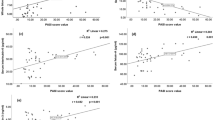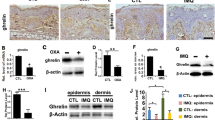Abstract
The G-protein-coupled receptors GPR43 and GPR109a are known to play an important role in mediating anti-inflammatory and anti-cancer functions in the gut. Short-chain fatty acids, such as sodium butyrate (SB), are activators of GPR43 and GPR109a and thereby promote anti-inflammatory effects. The present study aimed to examine the expression of these receptors and their reaction to SB in psoriasis. Lesional and non-lesional biopsies of 6 psoriasis patients and of 4 controls were obtained and stained for GPR109a and GPR43. Ex vivo stimulation with SB was performed on fresh biopsy material. Lesional and non-lesional psoriatic skin showed a decreased expression of GPR109a and GPR43 on keratinocytes in comparison with control skin. Topical application of SB was able to increase the low-level expression of both receptors. The data suggest that SB by restoring the impaired expression of GPR109a and GPR43 might exert anti-inflammatory effects and may be utilized as a topical tool for the treatment of psoriasis, which has to be proven in future clinical trials.




Similar content being viewed by others
Abbreviations
- GPR:
-
G-protein-coupled receptor(s)
- SB:
-
Sodium butyrate
- SCFA:
-
Short-chain fatty acids
- Treg:
-
Regulatory T cell(s)
References
Girish V, Vijayalakshmi A (2004) Affordable image analysis using NIH Image/ImageJ. Indian J Cancer 41(1):47
Andrés RM, Montesinos MC, Navalón P, Payá M, Terencio MC (2013) NF-κB and STAT3 inhibition as a therapeutic strategy in psoriasis: in vitro and in vivo effects of BTH. J Invest Dermatol 133:2362–2371
Asadullah K, Sabat R, Friedrich M, Volk HD, Sterry W (2004) Interleukin-10: an important immunoregulatory cytokine with major impact on psoriasis. Curr Drug Targets Inflamm Allergy 3:185–912
Bergboer JGM, Zeeuwen PLJM, Schalkwijk J (2012) Genetics of psoriasis: evidence for epistatic interaction between skin barrier abnormalities and immune deviation. J Invest Dermatol 132:2320–2331
Bermudez Y, Benavente CA, Meyer RG, Coyle WR, Jacobson MK, Jacobson EL (2011) Nicotinic acid receptor abnormalities in human skin cancer: implications for a role in epidermal differentiation. PLoS One 6:e20487
Bhatt B, Zeng P, Zhu H, Sivaprakasam S, Li S, Xiao H, Dong L, Shiao P, Kolhe R, Patel N, Li H, Levy-Bercowski D, Ganapathy V, Singh N (2018) Gpr109a limits microbiota-induced IL-23 production to constrain ILC3-mediated colonic inflammation. J Immunol 200:2905–2914
Boehncke WH (2018) Systemic inflammation and cardiovascular comorbidity in psoriasis patients: causes and consequences. Front Immunol 9:579
Boesmans L, Ramakers M, Arijs I, Windey K, Vanhove W, Schuit F, Rutgeerts P, Verbeke K, De Preter V (2015) Inflammation-induced downregulation of butyrate uptake and oxidation is not caused by a reduced gene expression. J Cell Physiol 230:418–426
Chen G, Ran X, Li B, Li Y, He D, Huang B, Fu S, Liu J, Wang W (2018) Sodium butyrate inhibits inflammation and maintains epithelium barrier integrity in a TNBS-induced inflammatory bowel disease mice model. EBioMedicine 30:317–325
Codoñer FM, Ramírez-Bosca A, Climent E, Carrión-Gutierrez M, Guerrero M, Pérez-Orquín JM, de la Parte JH, Genovés S, Ramón D, Navarro-López V, Chenoll E (2018) Gut microbial composition in patients with psoriasis. Sci Rep 8:3812
Elangovan S, Pathania R, Ramachandran S, Ananth S, Padia RN, Lan L, Singh N, Martin PM, Hawthorn L, Prasad PD, Ganapathy V, Thangaraju M (2014) The niacin/butyrate receptor GPR109A suppresses mammary tumorigenesis by inhibiting cell survival. Cancer Res 74:1166–1178
Ghoreschi K, Thomas P, Breit S, Dugas M, Mailhammer R, van Eden W, van der Zee R, Biedermann T, Prinz J, Mack M, Mrowietz U, Christophers E, Schlöndorff D, Plewig G, Sander CA, Röcken M (2003) Interleukin-4 therapy of psoriasis induces Th2 responses and improves human autoimmune disease. Nat Med 9:40–46
Iraporda C, Errea A, Romanin DE, Cayet D, Pereyra E, Pignataro O, Sirard JC, Garrote GL, Abraham AG, Rumbo M (2015) Lactate and short chain fatty acids produced by microbial fermentation downregulate proinflammatory responses in intestinal epithelial cells and myeloid cells. Immunobiology 220:1161–1169
Jeninga EH, Bugge A, Nielsen R, Kersten S, Hamers N, Dani C, Wabitsch M, Berger R, Stunnenberg HG, Mandrup S, Kalkhoven E (2009) Peroxisome proliferator-activated receptor gamma regulates expression of the anti-lipolytic G-protein-coupled receptor 81 (GPR81/Gpr81). J Biol Chem 284:26385–26393
Kim CH (2018) Immune regulation by microbiome metabolites. Immunology 154:220–229
Kim MH, Kang SG, Park JH, Yanagisawa M, Kim CH (2013) Short-chain fatty acids activate GPR41 and GPR43 on intestinal epithelial cells to promote inflammatory responses in mice. Gastroenterology 145:396–406
Korn T, Bettelli E, Oukka M, Kuchroo VK (2009) IL-17 and Th17 cells. Annu Rev Immunol 27:485–517
Langan EA, Griffiths CEM, Solbach W, Knobloch JK, Zillikens D, Thaçi D (2018) The role of the microbiome in psoriasis: moving from disease description to treatment selection? Br J Dermatol 178:1020–1027
Mrowietz U, Morrison PJ, Suhrkamp I, Kumanova M, Clement B (2018) The pharmacokinetics of fumaric acid esters reveal their in vivo effects. Trends Pharmacol Sci 39:1–12
Ochoa-Repáraz J, Mielcarz DW, Ditrio LE, Burroughs AR, Foureau DM, Haque-Begum S, Kasper LH (2009) Role of gut commensal microflora in the development of experimental autoimmune encephalomyelitis. J Immunol 83:6041–6050
Ochoa-Repáraz J, Mielcarz DW, Wang Y, Begum-Haque S, Dasgupta S, Kasper DL, Kasper LH (2010) A polysaccharide from the human commensal Bacteroides fragilis protects against CNS demyelinating disease. Mucosal Immunol 3:487–495
Rizzo HL, Kagami S, Phillips KG, Kurtz SE, Jacques SL, Blauvelt A (2011) IL-23-mediated psoriasis-like epidermal hyperplasia is dependent on IL-17A. J Immunol 186:1495–1502
Schneider CA, Rasband WS, Eliceiri KW (2012) NIH Image to ImageJ: 25 years of image analysis. Nat Methods 9:671–675
Schwarz A, Bruhs A, Schwarz T (2017) The short-chain fatty acid sodium butyrate functions as a regulator of the skin immune system. J Invest Dermatol 137:855–864
Shimoura N, Nagai H, Fujiwara S, Jimbo H, Yoshimoto T, Nishigori C (2017) Interleukin (IL)-18, cooperatively with IL-23, induces prominent inflammation and enhances psoriasis-like epidermal hyperplasia. Arch Dermatol Res 309:315–321
Singh N, Gurav A, Sivaprakasam S, Brady E, Padia R, Shi H, Thangaraju M, Prasad PD, Manicassamy S, Munn DH, Lee JR, Offermanns S, Ganapathy V (2014) Activation of Gpr109a, receptor for niacin and the commensal metabolite butyrate, suppresses colonic inflammation and carcinogenesis. Immunity 40:128–139
Tang H, Lu JY, Zheng X, Yang Y, Reagan JD (2008) The psoriasis drug monomethylfumarate is a potent nicotinic acid receptor agonist. Biochem Biophys Res Commun 375:562–565
Trompette A, Gollwitzer ES, Yadava K, Sichelstiel AK, Sprenger N, Ngom-Bru C, Blanchard C, Junt T, Nicod LP, Harris NL, Marsland BJ (2014) Gut microbiota metabolism of dietary fiber influences allergic airway disease and hematopoiesis. Nat Med 20:159–166
Acknowledgements
We thank Ms. Katharina Pallasch for excellent technical assistance.
Author information
Authors and Affiliations
Corresponding author
Ethics declarations
Conflict of interest
The authors declare that they have no conflict of interest.
Ethical approval
All procedures performed in studies involving human participants were in accordance with the ethical standards of the institutional and/or national research committee and with the 1964 Helsinki declaration and its later amendments or comparable ethical standards.
Informed consent
Informed consent was obtained from all individual participants included in the study.
Rights and permissions
About this article
Cite this article
Krejner, A., Bruhs, A., Mrowietz, U. et al. Decreased expression of G-protein-coupled receptors GPR43 and GPR109a in psoriatic skin can be restored by topical application of sodium butyrate. Arch Dermatol Res 310, 751–758 (2018). https://doi.org/10.1007/s00403-018-1865-1
Received:
Revised:
Accepted:
Published:
Issue Date:
DOI: https://doi.org/10.1007/s00403-018-1865-1




